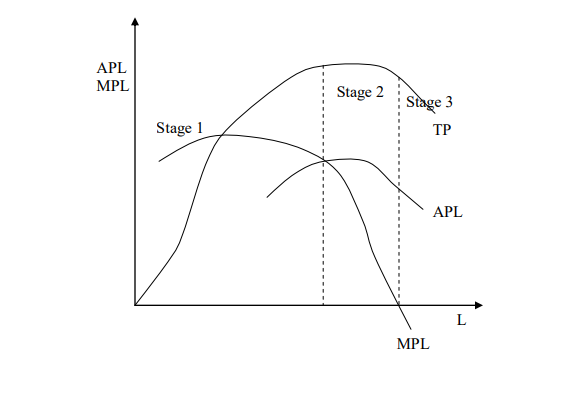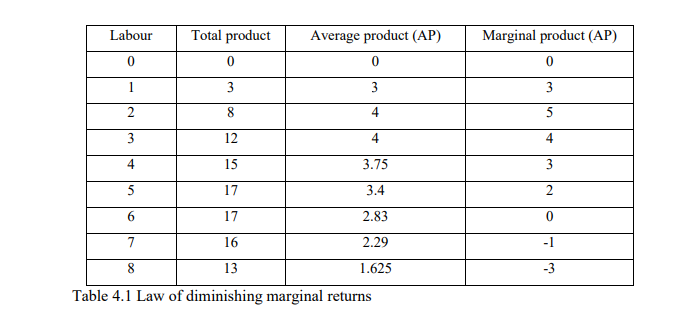This is a technical relationship between the output of good and the input required to make these goods. The function may take the form of an equation, a table or a graph. The relationship between an input and output is a technological relationship which may be the
short run or long run.
Q = f (K, L) where Q-output; K-capital; L – Labour
Short run refers to a period of time in which only some variables change. It is an economic process during which supply of certain factors of production e.g. land are fixed and cannot be varied.
Long run refers to a period of time in which all variables are able to settle at their equilibrium and all economic processes have time to work in full.
Average product (AP) is the output per unit of the variable factors and it‟s given by:
AP = Total product (TP)
Number unit of variable factors
E.g. the average product of workers and capital are given by:
AP = TP; AP = TP
L K
Marginal products it is changes in the total product brought about by varying the employment of the variable factors by one unit e.g. increasing employment by 1 person.
MP = Change in total product
Change in quality of labour employment
= ∆TP
∆L
Fixed Costs – are costs that do not change as output varies. They are associated with fixed factors of production and include; rent rates, insurance, interest on loans and depreciation. Fixed costs remain the same whether output is one unit or output is 1,000
units. Fixed costs are also referred to as overhead costs or unavoidable costs.
Depreciation, especially in capital intensive industries usually constitute a major item in fixed costs since the life of capital tends to be measured in economic rather than technical terms and machinery, for example, depreciates even when not in use.
Variable Costs- are costs that are related directly to output and include the wages of labour, the costs of raw materials, fuel and power. Variable costs are alternatively known as direct or prime costs.
Total Costs represent the sum of fixed costs (FC) and variable costs (VC).
TC = FC+VC
When output is equal to zero, total costs will be equal fixed costs since variable costs will be zero. When production begins to increase total costs will continue to rise as variable costs increase since output expands.
Law of Diminishing Marginal Returns/Law of Variable Proportion It states that holding other factors constant as additional unit of a variable factor are added to a given quantity of a fixed factors, the total product and the marginal product will initially increase at an increasing rate but beyond a certain level of output it will increase at a decreasing rate and eventually fall.

Stage 1
There is increasing returns to the variable factors. In this stage the total product is increasing at an increasing rate while the marginal product and average product are also rising with marginal product higher than average product at any given point. This is an
indication of increasing efficiency of the proportion in which the factors are combined since the fixed factors are still under utilized and there is greater scope of specialization.
Stage 2
It represents a decreasing return to the variable factors in that the total product is increasing at a decreasing rate. The marginal product and the average product are positive but they are falling at this stage. The average product is higher than the marginal product
and only national production takes place.
Stage 3
This represents a stage of negative return of the variable factors. At this stage the marginal product is negative and as a result the total output is reducing. It represents a stage of extreme inefficiency when factors of production are probably getting into each other’s way (conflicting). At this stage the producer will not operate even with free labour, since he could also raise the total output by using less labour. The law of diminishing marginal returns is explained by the use of the schedule in Table

The average product curve raises at first, reaches the maximum and then falls. It remains a positive as long as the total product is positive. The marginal product rises and reaches the maximum before the average product and then declines. The marginal product
becomes zero when the total product starts to decline. Therefore the falling portion of marginal product curve illustrates the law of diminishing returns.
Assumptions
1) The state of technology remains unchanged.
2) Successive units of the variable factors are assumed to be equally efficient
3) Production take place in the short run where at least one factor of production is fixed.
4) There is one variable factor of production under consideration.